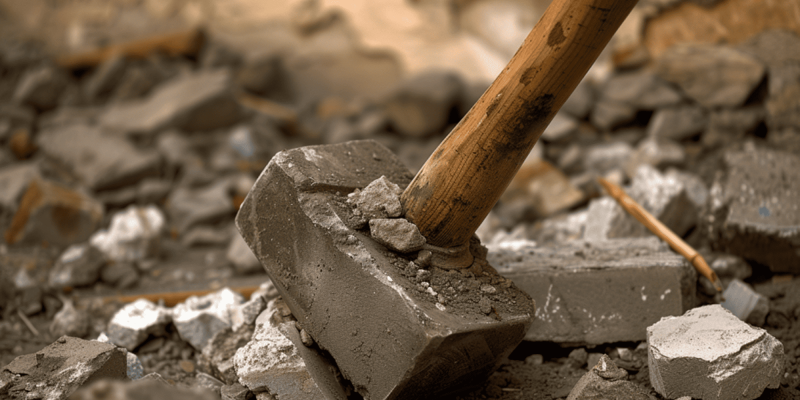Ever looked at that old, cracked patio or driveway in your home and wondered how you could remove it? Breaking up concrete might seem tough, but with the right approach, it’s something you can tackle. This guide will show you how to safely and effectively break up concrete, whether you’re planning a small garden project or a larger renovation.
Preparing for Concrete Demolition
Before you start swinging a sledgehammer, there’s a bit of planning to do. Knowing what you’re dealing with will help you choose the best tools and approach.
Assessing the Project Scope
Look at the concrete area you want to remove. Is it a small sidewalk or a big patio? The thickness of the concrete matters too. Thin slabs are easier to break than thick ones.
Safety First
Safety gear is a must. Always wear goggles to protect your eyes from flying debris, gloves to keep your hands safe, and ear protection because breaking concrete can be really loud. Another important step is to call 811. This is a free service that will tell you if there are any underground utilities like gas or water lines where you’re planning to dig. You don’t want to accidentally hit one of these!
Tools and Materials Needed
You’ll need some tools and materials to get the job done right.
- Essential Tools:
- Sledgehammer: Great for smaller, thinner slabs.
- Jackhammer: Best for thicker concrete; you can rent one if you don’t own it.
- Pry Bar: Useful for lifting and prying up broken pieces of concrete.
- Bolt Cutters and Circular Saw: Needed if there’s metal wire or rebar in the concrete.
- Materials for the Job:
- 4-Mil Plastic Sheeting: Use this to cover nearby areas to protect them from flying debris.
- Tool Rental Options: If you don’t have these tools, don’t worry. Many hardware stores in Joliet offer rental services for the tools you’ll need.
Breaking Up Concrete Step-by-Step
Now, let’s get into the steps for actually breaking up the concrete.
- Planning Your Approach: Start by deciding where to begin breaking the concrete. If it’s a large area, breaking it into smaller sections can make the job easier.
- Techniques for Different Concrete Types:
- For thin slabs (less than 4 inches thick), a sledgehammer might be all you need. Hit the concrete near the edge and work your way in.
- For thicker slabs, a jackhammer is your best bet. It’s a powerful tool, so make sure to use it carefully.
- Practical Tips for Efficiency: Always start from the outer edge and work your way towards the center. This makes it easier to break the concrete into manageable pieces.
Let’s continue with the next sections in a follow-up to ensure clarity and focus on each part.
Handling Reinforcement and Obstacles
Sometimes, concrete has metal inside it, like wire mesh or rebar. This makes the job a bit trickier, but not impossible.
- Dealing with Rebar and Wire Mesh: If you find metal reinforcements, you’ll need more than just brute force. Bolt cutters can snip through wire mesh easily. For rebar, which is much thicker, you might need a circular saw with a metal-cutting blade. Be careful and go slow, as cutting metal can produce sparks and sharp edges.
- Overcoming Common Challenges: Thick or reinforced concrete isn’t the only hurdle you might face. Sometimes, the concrete is too hard, or it’s in a tricky spot. If the sledgehammer isn’t doing the trick, try using a jackhammer to create small cracks and weaken the structure. Remember, the key is patience and persistence. Work in sections and take breaks to avoid getting tired or frustrated.
Disposal of Concrete Rubble
Once you’ve broken up your concrete, you’ll need to get rid of the rubble.
- Rubble Removal Methods: You can haul the broken pieces away in a truck or trailer if you have one. Some waste management companies in Joliet offer pickup services for large debris like concrete, but there may be a fee. Check with your local waste services for regulations and options.
- Environmental Considerations: Think about recycling the concrete instead of just throwing it away. Concrete can often be recycled and used in other construction projects. Look for a local recycling center that accepts construction materials. Not only is this good for the planet, but it might also save you some money on disposal fees.
When to Hire a Professional
Breaking up concrete is hard work, and it’s not for everyone. Sometimes, it’s best to call in a pro.
- Assessing the Difficulty: If your concrete slab is more than 4 inches thick, reinforced with a lot of metal, or you’re not confident in your ability to handle the tools safely, it might be time to hire a professional.
- Finding and Choosing Contractors: Look for experienced contractors in Joliet who specialize in concrete demolition. Get a few quotes, check references, and make sure they are licensed and insured. A good contractor will be able to tackle any job, big or small, without risking damage to your property or the surrounding area.
Conclusion
Breaking up concrete can seem daunting, but with the right tools, techniques, and a bit of know-how, it’s definitely achievable for the motivated homeowner. Remember to plan your project carefully, prioritize safety, and consider the environmental impact of disposal. And, if the job looks too big or too complicated, there’s no shame in calling in the professionals. Whether you decide to DIY or hire help, you’re now one step closer to transforming your space in Joliet, Illinois.
This guide aims to empower homeowners with the knowledge and confidence needed to tackle concrete demolition projects or make informed decisions about hiring professionals.

